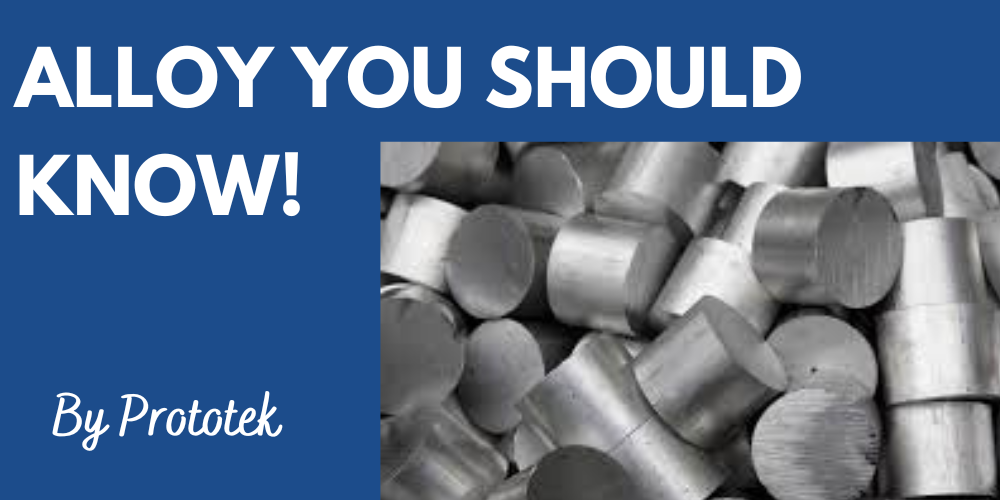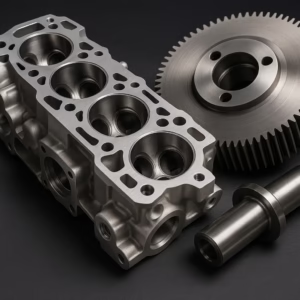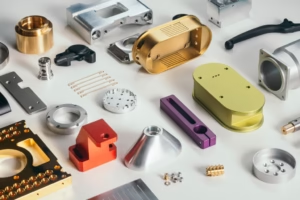Exploring the World of Aluminum Forging Alloy – A Prototek Perspective
Aluminum forging alloys play a pivotal role in various industries, offering lightweight properties, strength, and corrosion resistance. This article delves into the significance, types, characteristics, production processes, applications, and prospects of aluminum forging alloys.
Overview of Aluminum Forging Alloys
Aluminum forging alloys are essential in various industries for their exceptionally lightweight properties, strength, and corrosion resistance. These alloys undergo the forging process, where aluminum billets are shaped into desired forms under heat and pressure. Resulting in components with superior mechanical properties.
Definition:
Aluminum forging alloys are specifically formulated materials designed to withstand the rigors of the forging process. They are engineered to exhibit excellent formability, machinability, and mechanical strength. Making them ideal for applications where lightweight yet robust components are required.
Applications:
The versatility of aluminum forging alloys makes them indispensable in numerous industries. They are extensively used in automotive manufacturing for engine parts, transmission components, and suspension systems. Due to their lightweight nature and high strength-to-weight ratios, these alloys are vital for aircraft structural components, landing gear, and engine parts in the aerospace industry. Additionally, aluminum forging alloys find applications in marine equipment, sporting goods, and architectural structures. Where their corrosion resistance and formability are highly valued.
Advantages and Limitations:
Aluminum forging alloys offer several advantages, including high strength-to-weight ratios, excellent corrosion resistance, and good machinability. Their lightweight nature contributes to fuel efficiency in automotive and aerospace applications while maintaining structural integrity. However, these alloys may have limitations in terms of weldability and formability, requiring careful consideration during the design and manufacturing process.
Types of Aluminum Forging Alloys
Aluminum forging alloys are categorized into different series, each with its distinct properties and applications. Among the most commonly used series are the 2XXX and 6XXX series, known for their specific characteristics and widespread industrial usage.
2XXX Series Alloys:
The 2XXX series aluminum alloys are characterized by their high strength and excellent fatigue resistance. We are making them well-suited for applications in demanding environments, particularly in the aerospace industry. Alloys such as 2024 and 2014 are prime examples of this series and are extensively utilized in aircraft structural components. Including fuselage frames, wing spars, and bulkheads. These alloys offer exceptional strength-to-weight ratios, essential for maintaining structural integrity while minimizing overall weight.
6XXX Series Alloys:
Aluminum alloys within the 6XXX series are renowned for their good formability, weldability, and corrosion resistance, making them versatile materials suitable for various applications. Alloys like 6061 and 6063 are highly sought after in the automotive, marine, and architectural industries due to their excellent combination of mechanical properties and ease of fabrication. They are commonly used in automotive components, extruded profiles, and structural frameworks where lightweight, durable materials are required.
Other Important Series:
In addition to the 2XXX and 6XXX series, several other notable series of aluminium forging alloys cater to specific industrial needs. For instance, the 7XXX series alloys offer exceptional strength and toughness, making them suitable for high-performance applications such as aerospace and defense. The 5XXX series alloys, on the other hand, are known for their excellent corrosion resistance and are commonly used in marine and chemical processing industries.
Each series of aluminium forging alloys is engineered to meet the unique requirements of various applications. They provide manufacturers with a wide array of options based on performance, cost-effectiveness, and processing capabilities. By understanding the characteristics and applications of these alloys, engineers, and designers can select the most suitable materials for their specific manufacturing needs.
Characteristics of Aluminum Forging Alloys
Aluminium forging alloys possess various characteristics that make them highly desirable materials for various applications across different industries. These characteristics contribute to their widespread use and effectiveness in meeting the demands of modern manufacturing processes.
Mechanical Performance:
One of the key characteristics of aluminium forging alloys is their impressive mechanical performance. These alloys exhibit excellent strength-to-weight ratios, allowing for the fabrication of lightweight components without compromising on structural integrity. Whether in tension, compression, or shear, aluminium forging alloys demonstrate remarkable mechanical properties. Making them suitable for critical applications where strength and durability are paramount.
Résistance à la corrosion :
Another significant characteristic of aluminium forging alloys is their exceptional corrosion resistance. Aluminium naturally forms a protective oxide layer on its surface, which protects against environmental factors such as moisture, chemicals, and saltwater exposure. This inherent corrosion resistance makes aluminium forging alloys ideal for use in marine environments, chemical processing plants, and other applications where exposure to corrosive elements is a concern.
Heat Treatability:
Aluminium forging alloys are highly heat treatable, allowing precise control over their mechanical properties through various heat treatment processes. Heat treatment can significantly enhance these alloys’ strength, hardness, and toughness, making them suitable for applications requiring specific performance criteria. By carefully manipulating the material’s microstructure through processes such as quenching and aging. Manufacturers can tailor the properties of aluminium forging alloys to meet the requirements of their intended application.
Machinability:
Aluminum forging alloys exhibit good machinability, facilitating ease of fabrication and production efficiency. These alloys can be readily machined using conventional methods such as milling, drilling, turning, and grinding, allowing for the creation of complex shapes and intricate designs. Their excellent machinability enables manufacturers to achieve tight tolerances and high-quality surface finishes, resulting in components that meet strict performance standards.
Recyclability:
A notable characteristic of aluminium forging alloys is their recyclability, contributing to their sustainability and environmental friendliness. Aluminum is one of the most recycled materials in the world, able to be repeatedly recycled without losing its inherent properties. Recycling consumes significantly less energy than primary aluminum production. Making recycled aluminum forging alloys an economically viable and environmentally responsible choice for manufacturers.
In summary, aluminum forging alloys’ characteristics, including their mechanical performance, corrosion resistance, heat treatability, machinability, and recyclability, make them versatile and valuable materials for various applications. By leveraging these characteristics, manufacturers can produce high-quality components that meet modern industry’s rigorous demands while promoting sustainability and environmental stewardship.
Production Processes for Aluminum Forging Alloys
The production of aluminum forging alloys involves several intricate processes to transform raw materials into high-quality alloys suitable for forging. These processes ensure that the resulting alloys possess the properties and characteristics required for their intended applications.
Billet Preparation: The production process typically begins with the preparation of aluminum billets, which serve as the raw material for forging. Billets are usually produced through a combination of casting and extrusion processes. Molten aluminum is cast into ingots of specific shapes and sizes, which are then extruded to form cylindrical or rectangular billets. The composition and homogeneity of the billets are carefully controlled to ensure consistent material properties throughout the forging process.
Alloy Preparation: Once the billets are formed, they undergo alloy preparation to enhance their mechanical properties and performance characteristics. This may involve adding alloying elements such as copper, magnesium, or silicon to improve strength, hardness, and corrosion resistance. Alloying elements are carefully selected based on the final product’s desired properties and added in precise quantities to achieve the desired alloy composition.
Forging Techniques: Forging involves shaping aluminum billets into the desired forms using heat and pressure. Various forging techniques may be employed, depending on the complexity of the part and the desired final properties. Common forging techniques include:
- Open-Die Forging: In open-die forging, the billet is placed between flat or shaped dies and subjected to compressive forces to deform it into the desired shape. This technique is suitable for producing large, simple shapes with minimal material wastage.
- Closed-Die Forging: Closed-die forging involves using specially designed dies that enclose the billet, allowing for more intricate shapes and tighter tolerances. The billet is compressed within the dies to produce the desired form, resulting in precise and highly detailed components.
- Ring Rolling: Ring rolling is a specialized forging technique that produces seamless rings or cylindrical shapes. The billet is placed between two rotating rolls, which apply radial pressure to deform the billet into a ring shape. This process commonly produces bearing races, flanges, and other circular components.
Heat Treatment: After forging, aluminum alloys may undergo heat treatment to enhance their mechanical properties further. Heat treatment involves heating the forged components to specific temperatures and then cooling them at controlled rates to achieve the desired microstructure and properties. Common heat treatment processes for aluminum forging alloys include solution heat treatment, quenching, and aging, which can improve strength, hardness, and toughness while relieving internal stresses introduced during forging.
Opérations de finition : Once the forging and heat treatment processes are complete, the resulting components may undergo various finishing operations to achieve the desired dimensions, surface finish, and mechanical properties. These operations may include machining, grinding, polishing, and surface coating to ensure the components meet the required specifications and quality standards.
Applications of Aluminum Forging Alloys
Aluminum forging alloys find widespread applications across various industries due to their unique combination of properties, including lightweight, strength, corrosion resistance, and versatility in fabrication. From automotive to aerospace, marine to construction, these alloys play a critical role in producing components and parts that require high performance and reliability.
Automotive Industry: In the automotive sector, aluminum forging alloys are extensively used to produce lightweight components that contribute to fuel efficiency, performance, and safety. Engine parts, transmission components, suspension systems, and wheels are commonly manufactured using aluminum forging alloys due to their high strength-to-weight ratios and excellent machinability. These components’ reduced weight helps enhance vehicle efficiency and reduce emissions while maintaining structural integrity and durability.
Aerospace Industry: The aerospace industry relies heavily on aluminium forging alloys to produce aircraft structural components, landing gear, engine parts, and other critical systems. Aluminum alloys’ lightweight nature and high strength and corrosion resistance make them ideal for aerospace applications where every ounce of weight savings is crucial. Aluminum forging alloys offer exceptional performance under extreme conditions, ensuring the safety and reliability of aircraft components.
Marine Equipment: Aluminum forging alloys are also widely used in the marine industry to produce marine equipment and components. Their corrosion resistance makes them well-suited for use in saltwater environments, where exposure to moisture and harsh conditions can lead to corrosion and degradation of materials. Components such as boat hulls, propellers, fittings, and marine hardware benefit from the lightweight and durable properties of aluminium forging alloys, contributing to the performance and longevity of marine vessels.
Sporting Goods: Sporting goods manufacturers utilize aluminium forging alloys to produce a wide range of products, including bicycle frames, golf club heads, tennis racket frames, and firearm components. The lightweight nature of aluminium alloys makes them ideal for applications where strength, durability, and maneuverability are essential. Aluminum forging alloys offer athletes and outdoor enthusiasts high-performance equipment that enhances their competitive edge and recreational experience.
Construction Industry: In the construction industry, aluminium forging alloys are employed for various structural and architectural applications. Including building facades, curtain walls, window frames, and structural components. Their lightweight yet sturdy properties make them an attractive choice for architects and builders seeking to design modern, energy-efficient structures. Aluminum forging alloys offer versatility in design, ease of fabrication, and resistance to corrosion, making them suitable for both aesthetic and functional elements in construction projects.
Current Trends and Challenges
Technological Innovations: Ongoing advancements in alloy design, forging techniques, and heat treatment processes drive the development of aluminum forging alloys with enhanced properties and performance.
Sustainability Challenges: The industry faces challenges related to the sustainability of aluminium production and forging processes, necessitating a focus on recycling and environmentally friendly practices.
Market Trends: This report provides insights into current market trends, including the increasing demand for lightweight materials in the automotive and aerospace industries and the growing emphasis on energy efficiency and sustainability.
Conclusion
In conclusion, aluminum forging alloys are indispensable materials in modern manufacturing, offering a unique combination of strength, lightweight properties, and corrosion resistance. As industries continue to evolve, these alloys are poised to play an even more significant role in shaping the future of engineering and technology. Embracing innovation while addressing sustainability challenges will be key to unlocking their full potential in the years to come.
If you have any needs, contact us via email at Lynnyao@prototekparts.com ou par téléphone : +86-0792-86372550
Tags :
- metal stamping; aluminum alloy

























































